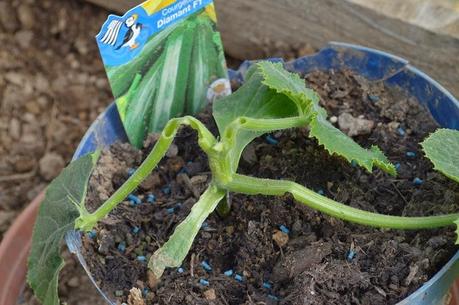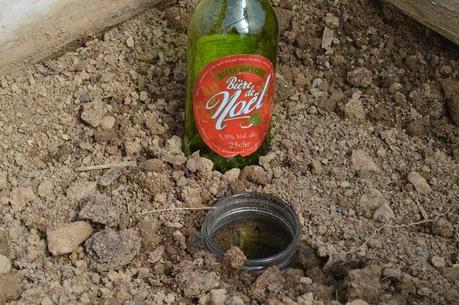
Other ways to deter slugs and snails from WikiHow
Plant other plants that deter slugs. Certain plants push slugs away from them, either because the slugs hate the texture or taste of the plants. Plants like swiss chard, ginger, garlic, chives, mint, red cabbage, chicory and foxglove will keep your garden clear of slugs. Plant these in a barrier around the entirety of your garden, or keep them around each individual plant. You can also choose to mix the leaves of these plants into the soil as a type of mulch, as well.

Beers traps work well
A honey and yeast trap. The same concept as the beer trap, slugs are highly attracted to the combination of honey and yeast. Boil a cup of water with equal parts of honey and yeast (the proportions don’t really matter), and then allow the mixture to cool. Dig a hole in your garden near where the slugs are the worst, and bury a cup or bowl with steep sides up to the rim. Fill the container about 80% of the way with your honey yeast mixture, and allow it to set overnight. By the morning, the container should be full of drowned slugs. Salt. Spread salt on the surface where they are crawling around and they will dry up. However, if you plan to use the soil to grow plants in, salt can very easily ruin the soil for plants. Use this around the base of potted plants on a porch, or place a barrier on the soil prior to spreading the salt in order to protect the integrity of the soil.
Create a pine-needle mulch. Dried out pine needles are like sharp little slug daggers, and will stab the slugs who try to pass over them. Collect the pine needles from the trees in your yard after they fall, or visit a local gardening center to pick some up. Spread these in a thick blanket around your plants to keep out the slugs. Keep in mind that pine needles are highly acidic, so you may have to mix some lime into the soil to balance it out.
Make a copper strip barrier. It isn’t known entirely why copper works so well to deter slugs, it’s theorized that the copper reacts electrostatically with the slug or snail slime. Regardless, it does work. Purchase strips of copper wide enough that the slugs can’t bridge it with their bodies. Place these in a barricade around your plants. While these are expensive, they are also a good alternative for protecting small areas or individual plants; try gluing them to the edges of your pots to keep out the slugs.
Make a pet food trap. Another strange attraction for slugs is that of cat food or dog food. The pet food won’t kill them, but it will lure them into a confined area which makes them easier to dispose of. Grab a tin (disposable) pie pan, and cut out little ‘doors’ from the metal rim. Place the tin upside down in your garden so that the slugs have access to the ‘doors’, and put some dry dog or cat food underneath. After several hours, you should be able to find multiple snails making refuge under the tin. Scoop them up and toss them out, and then re-set the trap for the next batch of unsuspecting gastropods.
Please let me know if you have any other ideas to deal with slugs and snails.

